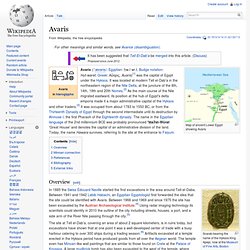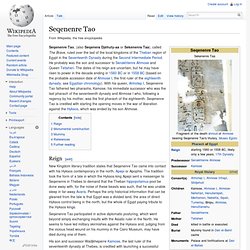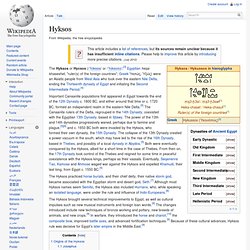

Avaris. Map of ancient Lower Egypt showing Avaris Overview[edit] In 1885 the Swiss Édouard Naville started the first excavations in the area around Tell-el-Daba.

Between 1941 and 1942 Labib Habachi, an Egyptian Egyptologist first forwarded the idea that the site could be identified with Avaris. Between 1966 and 1969 and since 1975 the site has been excavated by the Austrian Archaeological Institute.[4] Using radar imaging technology its scientists could identify in 2010 the outline of the city including streets, houses, a port, and a side arm of the River Nile passing through the city.[5] The site at Tell el-Dab'a, covering an area of about 2 square kilometers, is in ruins today, but excavations have shown that at one point it was a well-developed center of trade with a busy harbour catering to over 300 ships during a trading season.[6] Artifacts excavated at a temple erected in the Hyksos period have produced goods from all over the Aegean world.
Minoan connection[edit] Minoan civilization. Map of Minoan Crete The Minoan civilization was an Aegean Bronze Age civilization that arose on the island of Crete and flourished from approximately the 27th century BC to the 15th century BC.[1] It was rediscovered at the beginning of the 20th century through the work of British archaeologist Arthur Evans.

Will Durant referred to it as "the first link in the European chain. "[2] The early inhabitants of Crete settled as early as 128,000 BC, during the Middle Paleolithic age.[3][4] It was not until 5000 BC that the first signs of advanced agriculture appeared, marking the beginning of civilization. Overview[edit] The term "Minoan" was coined by Arthur Evans after the mythic "king" Minos.[5] Minos was associated in Greek myth with the labyrinth, which Evans identified with the site at Knossos. Chronology and history[edit] Rather than associate absolute calendar dates for the Minoan period, archaeologists use two systems of relative chronology.
History[edit] Seqenenre Tao. Seqenenre Tao, (also Seqenera Djehuty-aa or Sekenenra Taa), called The Brave, ruled over the last of the local kingdoms of the Theban region of Egypt in the Seventeenth Dynasty during the Second Intermediate Period.

He probably was the son and successor to Senakhtenre Ahmose and Queen Tetisheri. The dates of his reign are uncertain, but he may have risen to power in the decade ending in 1560 BC or in 1558 BC (based on the probable accession date of Ahmose I, the first ruler of the eighteenth dynasty, see Egyptian chronology). With his queen, Ahhotep I, Seqenenre Tao fathered two pharaohs, Kamose, his immediate successor who was the last pharaoh of the seventeenth dynasty and Ahmose I who, following a regency by his mother, was the first pharaoh of the eighteenth. Seqenenre Tao is credited with starting the opening moves in the war of liberation against the Hyksos, which was ended by his son Ahmose. Reign[edit] Monumental construction[edit] Mummy[edit] File:Knossos frise taureau.JPG. Hyksos. The Hyksos or Hycsos (/ˈhɪksɒs/ or /ˈhɪksoʊz/;[3] Egyptian heqa khaseshet, "ruler(s) of the foreign countries"; Greek Ὑκσώς, Ὑξώς) were an Asiatic people from West Asia who took over the eastern Nile Delta, ending the Thirteenth dynasty of Egypt and initiating the Second Intermediate Period.[4] Important Canaanite populations first appeared in Egypt towards the end of the 12th Dynasty c. 1800 BC, and either around that time or c. 1720 BC, formed an independent realm in the eastern Nile Delta.[5] The Canaanite rulers of the Delta, regrouped in the 14th Dynasty, coexisted with the Egyptian 13th Dynasty, based in Itjtawy.

The power of the 13th and 14th dynasties progressively waned, perhaps due to famine and plague,[5][6] and c. 1650 BC both were invaded by the Hyksos, who formed their own dynasty, the 15th Dynasty. Origins of the Hyksos[edit] There are various hypotheses as to the Hyksos' ethnic identity. Most archaeologists[who?] As to a Hyksos “conquest”, some archaeologists[who?]